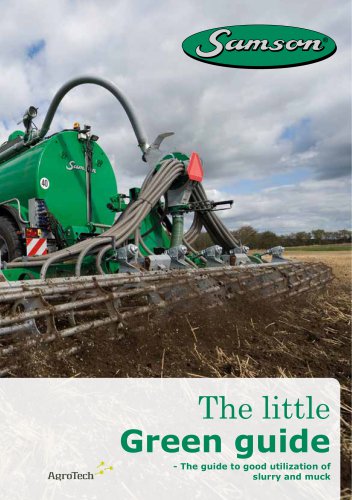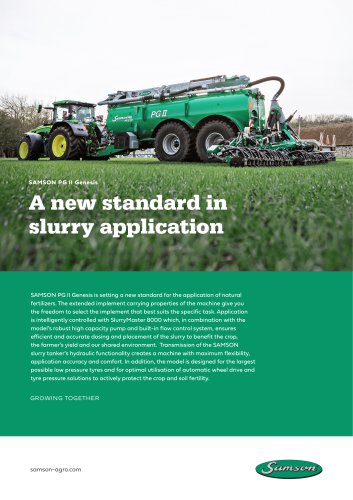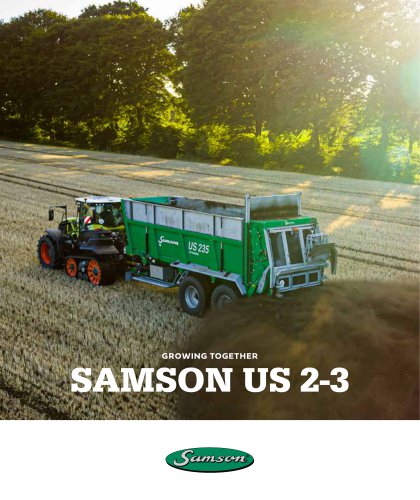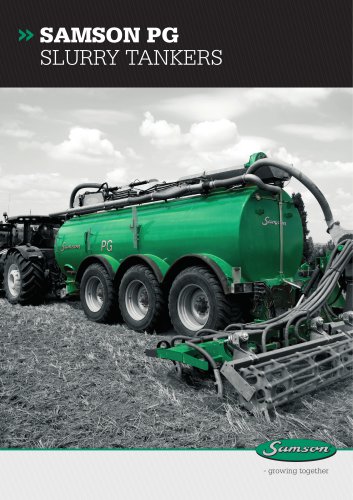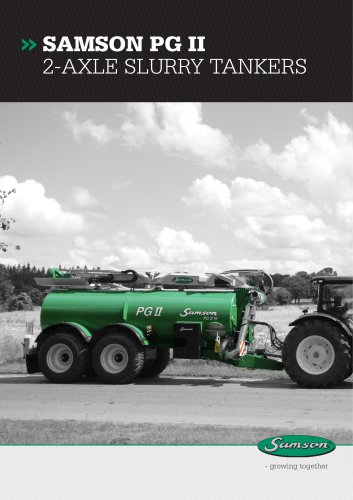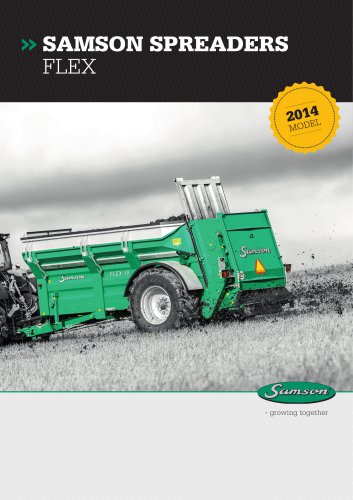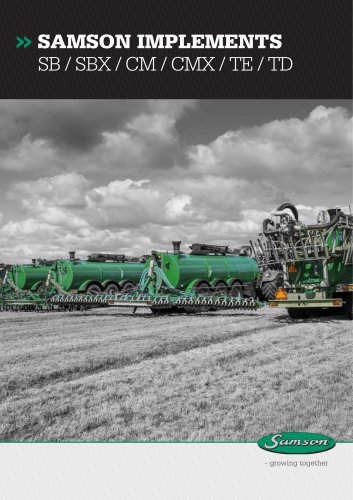
Catalog excerpts
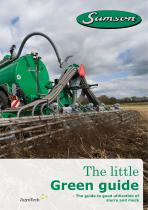
Green guide" The guide to good utilization of
Open the catalog to page 1
CONTENTS Slurry and muck is an important source of fertilizer Nutrient content What is slurry and muck worth? Nitrogen use efficiency is very variable Application method and ammonia losses The road to success with slurry and muck Which application method to choose? Sophisticated equipment needed Slurry and muck can harm the environment Reduce the risk of environmental problems Avoid the spread of disease from slurry and muck Glossary 20 More information “The little green guide – the road to good utilization of slurry and muck” is published by Samson Agro A/S TEXT: Torkild...
Open the catalog to page 2
Getting the best out of your slurry and muck requires a good strategy and the right machinery High usage, low impact THE USE OF SLURRY AND MUCK (ORGANIC FERTILIZER) IS A MUCH DEBATED ISSUE. This is because organic fertilizer is an important source of nutrients but can also adversely impact the environment if not handled correctly. TO ENSURE the efficient use of the nutrients in organic fertilizer and thus a low impact on the environment, SAMSON AGRO has a constant focus on improving application techniques. The Danish Agricultural Advisory Service (DLBR), AgroTech and the universities carry...
Open the catalog to page 3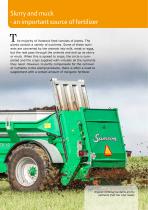
Slurry and muck - an important source of fertilizer he majority of livestock feed consists of plants. The plants contain a variety of nutrients. Some of these nutrients are converted by the animals into milk, meat or eggs, but the rest pass through the animals and end up as slurry or muck. When this is spread to crops, the circle is completed and the crops supplied with virtually all the nutrients they need. However, to partly compensate for the removal of nutrients in the animal products, there is often a need to supplement with a certain amount of inorganic fertilizer. Organic fertilizer...
Open the catalog to page 4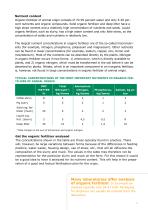
Nutrient content Organic fertilizer of animal origin consists of 70-95 percent water and only 5-30 percent nutrients and organic compounds. Solid organic fertilizer and deep litter have a high straw content and a relatively high concentration of nutrients and solids. Liquid organic fertilizer, such as slurry, has a high water content and only little straw, so the concentration of solids and nutrients is relatively low. The largest nutrient concentrations in organic fertilizer are of the so-called macronutrients (for example, nitrogen, phosphorus, potassium and magnesium). Other nutrients...
Open the catalog to page 5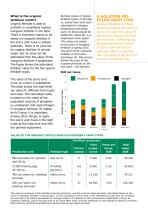
The value of the slurry and muck on a farm is substantial. The table shows the total fertilizer value for different farm types and sizes. The calculated value is based on the value of the equivalent amount of phosphorus, potassium and used nitrogen in inorganic fertilizer. To realise its full value, it is important, among other things, to apply the slurry and muck in the right crops at the right time and with the optimal equipment. Nutrient values of typical fertilizer types. In the figure, values have only been calculated for nitrogen, phosphorus and potassium. To these should be added the...
Open the catalog to page 6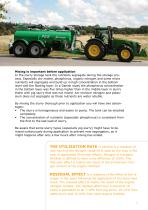
Mixing is important before application In the slurry storage tank the nutrients segregate during the storage process. Especially dry matter, phosphorus, organic nitrogen and some micro nutrients will segregate and build up in high concentration in the bottom layer and the floating layer. In a Danish study the phosphorus concentration in the bottom layer was five times higher than in the middle layer in slurry thank with pig slurry that was not mixed. Am monium nitrogen and potassium does not segregate as those nutrients are water soluble. By mixing the slurry thorough prior to application...
Open the catalog to page 7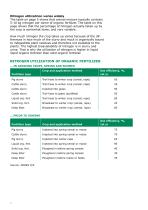
Nitrogen utilizatrion varies widely The table on page 5 shows that animal manure typically contains 5-10 kg nitrogen per tonne of organic fertilizer. The table on this page shows that the percentage of nitrogen actually taken up by the crop is somewhat lower, and very variable. How much nitrogen the crop takes up varies because of the differences in how much of the slurry and muck is organically bound to indigestible plant residues and therefore not available to the plants. The highest bioavailability of nitrogen is in slurry and urine. That is why the utilization of nitrogen is higher in...
Open the catalog to page 8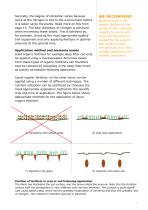
Secondly, the degree of utilization varies because some of the nitrogen is lost to the environment before it is taken up by the plants. Read more on this from page 15. The best utilization of nitrogen is achieved when minimising these losses. This is achieved by, for example, choosing the most appropriate application equipment and only applying fertilizer in optimal amounts at the optimal time. Application method and ammonia losses Solid organic fertilizer for example deep litter can only be applied using a muckspreader. Ammonia losses from these types of organic fertilizers can therefore...
Open the catalog to page 9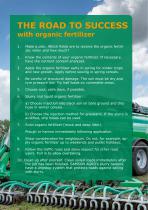
THE ROAD TO SUCCESS with organic fertilizer 1. Make a plan. Which fields are to receive the organic fertilizer, when and how much? Know the contents of your organic fertilizer. If necessary, have the nutrient content analyzed. Apply the organic fertilizer early in spring for winter crops and new growth. Apply before sowing in spring cereals. Be careful of structural damage. The soil must be dry and tyre pressure low. Try half loads on vulnerable areas. Choose cool, calm days, if possible. Slurry and liquid organic fertilizer: a) Choose injection into black soil on bare ground and drip hose...
Open the catalog to page 10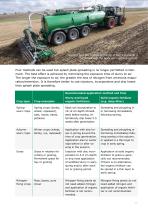
On light soils the highest utilization of slurry nutrients is achieved with the black soil injection method. Four methods can be used but splash plate spreading is no longer permitted in Denmark. The best effect is achieved by minimising the exposure time of slurry to air. The longer the exposure to air, the greater the loss of nitrogen from ammonia evaporation/emmision. It is therefore better to use injectors, incorporators and drip hoses than splash plate spreading. Recommended application method and time Slurry and liquid organic fertilizers Solid organic fertilizer (e.g. deep litter)...
Open the catalog to page 11All SAMSON AGRO A/S catalogs and technical brochures
-
SAMSON PG II Genesis
2 Pages
-
SAMSON TS
2 Pages
-
SAMSON US 2-3
11 Pages
-
PG
8 Pages
-
PG II 2-axle
20 Pages
-
PG II 3-axle
20 Pages
-
SG
8 Pages
-
SP
8 Pages
-
FLEX
12 Pages
-
SAMSON IMPLEMENTS
24 Pages

